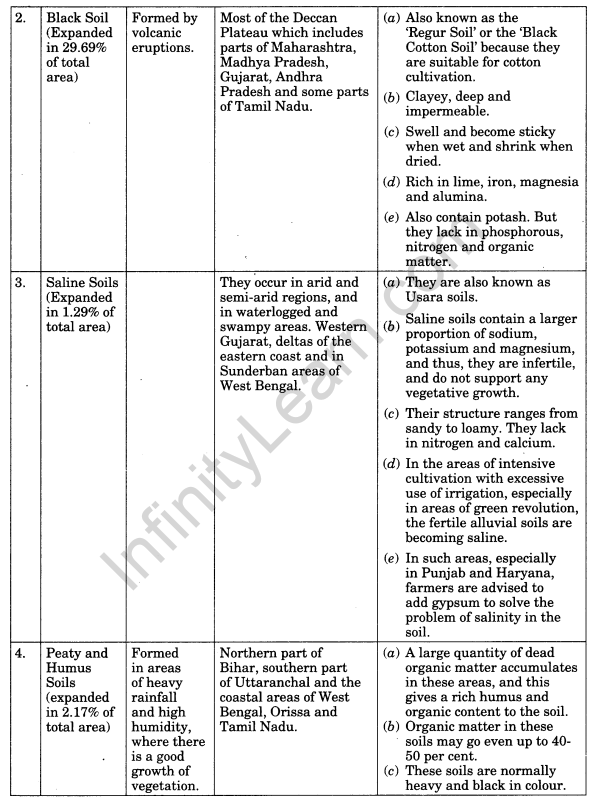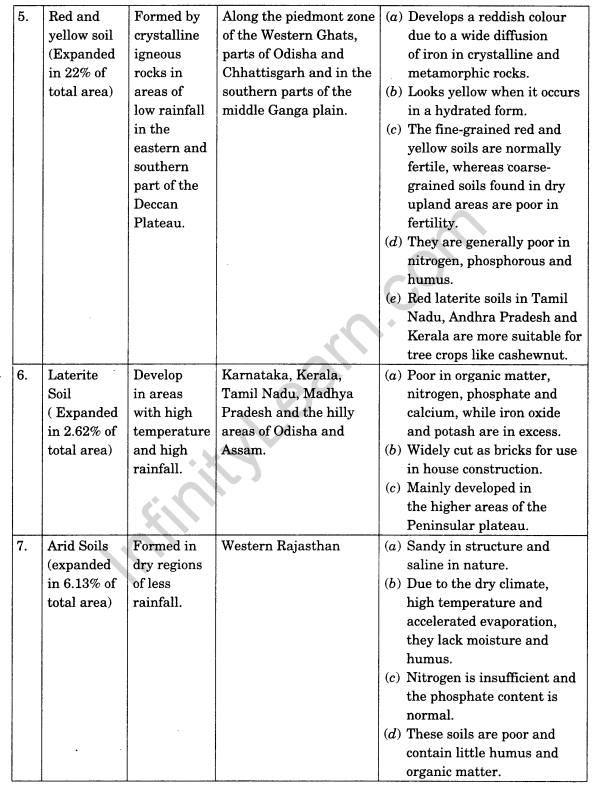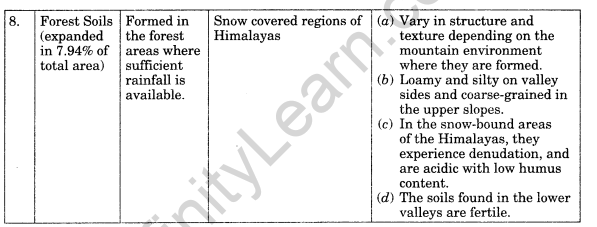Table of Contents
Class 11 Geography Notes Chapter 6 Soils
Soil is the mixture of rock debris and organic materials which develop on the earth’s surface.
The major factors affecting the formation of soil are relief, parent material, climate, vegetation and other life-forms and time. Besides these, human activities also influence it to a large extent.
Components of the soil are mineral particles, humus, water and air. The actual amount of each of these depends upon the type of soil.
Soil is bifurcated into three layers called horizons. ‘Horizon A’ is the topmost zone, where organic materials have got incorporated with the mineral matter, nutrients and water, which are necessary for the growth of plants. ‘Horizon B’ is a transition zone between the ‘horizon A’ and ‘horizon C’, and contains matter derived from below as well as from above. It has some organic matter in it, although the mineral matter is noticeably weathered. ‘Horizon C’ is composed of the loose parent material. This layer is the first stage in the soil formation process and eventually forms the above two layers.
In ancient times, soils used to be classified into twro main groups – Urvara and Usara, which were fertile and sterile, respectively.
In the 16th century A.D., soils were classified on the basis of their inherent characteristics and external features such as texture, colour, slope of land and moisture content in the soil. Based on texture, main soil types were identified as sandy, clayey, silty and loamy, etc. On the basis of colour, they wrere red, yellow, black, etc.
On the basis of genesis, colour, composition and location, the soils of India have been classified into:
- Alluvial soils
- Black soils
- Red and Yellow soils
- Laterite soils
- Arid soils
- Saline soils
- Peaty soils
- Forest soils.
Alluvial Soils Alluvial soils are widespread in the northern plains and the river valleys. These soils cover about 40 per cent of the total area of the country. They are depositional soils, transported and deposited by rivers and streams.
The alluvial soils vary in nature from sandy loam to clay. They are generally rich in potash but poor in phosphorous. In the Upper and Middle Ganga plain, two different types of alluvial soils have developed, viz. Khadar and Bhangar.
Khadar is the new alluvium and is deposited by floods annually, which enriches the soil by depositing fine silts. Bhangar represents a system of older alluvium, deposited away from the flood plains.
Black soil covers most of the Deccan Plateau which includes parts of Maharashtra, Madhya Pradesh, Gujarat, .Andhra Pradesh and some parts of Tamil Nadu. In the upper reaches of the Godavari and the Krishna, and the north western part of the Deccan Plateau, the black soil is very deep.
Red soil develops on crystalline igneous rocks in areas of low rainfall in the eastern and southern part of the Deccan Plateau. Along the piedmont zone of the Western Ghat, long stretch of area is occupied by red loamy soil.
Laterite has been derived from the Latin word ‘Later’ which means brick. The laterite soils develop in areas with high temperature and high rainfall. These are the result of intense leaching due to tropical rains. With rain, lime and silica are leached away, and soils rich in iron oxide and aluminium compound are left behind.
Arid soils range from red to brown in colour. They are generally sandy in structure and saline in nature. In some areas, the salt content is so high that common salt is obtained by evaporating the saline water. Due to the dry climate, high temperature and accelerated evaporation, they lack moisture and humus.
Saline soils are also known as Usara soils. Saline soils contain a larger proportion of sodium, potassium and magnesium, and thus, they are infertile, and do not support any vegetative growth. They have more salts, largely because of dry climate and poor drainage. They occur in arid and semi-arid regions, and in waterlogged and swampy areas.
Peaty soils are found in the areas of heavy rainfall and high humidity, where there is a good growth of vegetation. Thus, large quantity of dead organic matter accumulates in these areas, and this gives a rich humus and organic content to the soil. Organic matter in these soils may go even up to 40-50 per cent.
Forest soils are formed in the forest areas where sufficient rainfall is available. The soils vary in structure and texture depending on the mountain environment where they are formed. They are loamy and silty on valley sides and coarse-grained in the upper slopes.
Soil degradation can be defined as the decline in soil fertility, when the nutritional status declines and depth of the soil goes down due to erosion and misuse. Soil degradation is the main factor leading to the depleting soil resource base in India. The degree of soil degradation varies from place to place according to the topography, wind velocity and amount of the rainfall.
The destruction of the soil cover is described as soil erosion. Forest and other natural vegetation are removed for human settlement, for cultivation, for grazing animals and for various other needs. Wind and water are powerful agents of soil erosion because of their ability to remove soil and transport it.
Soil erosion is a serious problem for Indian agriculture and its negative eff ects are seen in other spheres also. Eroded materials are carried down to rivers and they lower down their carrying capacity, and cause frequent floods and damage to agricultural lands.
Deforestation is one of the major causes of soil erosion. Plants keep soils bound in locks of roots, and thus, prevent erosion. They also add humus to the soil by shedding leaves and twigs. The salt lodged in the lower profiles of the soil comes up to the surface and destroys its fertility. Chemical fertilizers in the absence of organic manures are also harmful to the soil.
If soil erosion and exhaustion are caused by humans; by corollary, they can also be prevented by humans. Contour bunding, Contour terracing, regulated forestry, controlled grazing, cover cropping, mixed farming and crop rotation are some of the remedial measures which are often adopted to reduce soil erosion.
Experiments have been made to stabilize sand dunes in western Rajasthan by the Central Arid Zone Research Institute (CAZRI). The Central Soil Conservation Board, set up by the Government of India, has prepared a number of plans for soil conservation in different parts of the country.
Important Soils Found In India:




Class 11 Geography Notes Chapter 6 Important Terms:
- Soil: Soil is the mixture of rock debris and organic materials which develop on the earth’s surface.
- Bad land topography: A region with a large number of deep gullies or ravines is called a bad land topography.
- Horizons: When we dig a pit on land and look at the soil, we find that it consists of three layers. These are called horizons.
- Horizon A: It is the topmost zone, where organic materials have got incorporated with the • mineral matter, nutrients and water, which are necessary for the growth of plants.
- Horizon B: It is a transition zone between the ‘horizon A’ and ‘horizon C’, and contains matter derived from below as well as from above. It has some organic matter in it, although the mineral matter is noticeably weathered.
- Horizon C: It is composed of the loose parent material. This layer is the first stage in the soil formation process and eventually forms the above two layers.
- Soil profile: The arrangement of layers in three horizons, A, B and C is known as the soil profile.
- Parent rock: Underneath the three horizons there is the rock which is known as the parent rock or the bedrock.
- Estuary: The tidal mouth of a river where fresh and saline water get mixed.
- Gully erosion: It is the erosion of the soil and rock by the concentration of runoff into gullies.
- Humus: The dead organic content of the soil.
- Khadar: Khadar is the new alluvium and is deposited by floods annually, which enriches the soil by depositing fine silts.
- Bhangar: Bhangar represents a system of older alluvium, deposited away from the flood plains.
- Alluvial soil: They are depositional soils, transported and deposited by rivers and streams.
- Laterite soil: Laterite has been derived from the Latin word ‘Later’ which means brick. The laterite soils develop in areas with high temperature and high rainfall.
- Black soil: These soils are made from volcanoes. These soils are also known as the ‘RegurSoil’ or the ‘Black Cotton Soil’.
- Forest soils: Forest soils are formed in the forest areas where sufficient rainfall is available.
- Peaty soils: They are found in the areas of heavy rainfall and high humidity, where there is a good growth of vegetation.
- Soil erosion: The destruction of the soil cover is described as soil erosion.
- Soil degradation: Soil degradation can be defined as the decline in soil fertility, when the nutritional status declines and depth of the soil goes down due to erosion and misuse. Soil degradation is the main factor leading to the depleting soil resource base in India.
- Soil Conservation: Soil conservation is a methodology to maintain soil fertility, prevent soil erosion and exhaustion, and improve the degraded condition of the soil.

